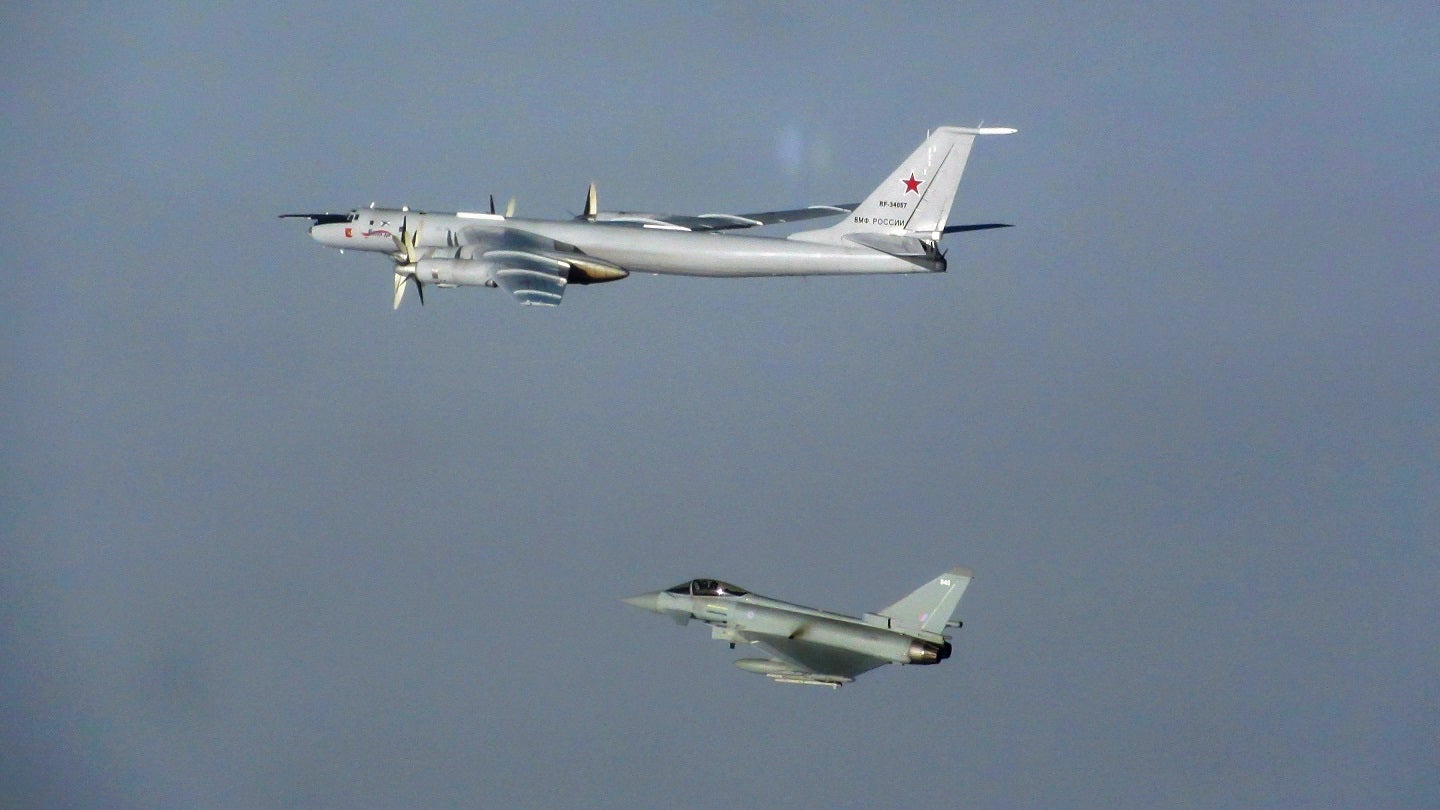
The UK Royal Air Force (RAF) has conducted twice as many Quick Reaction Aircraft (QRA) launches so far in 2023 as was recorded during the whole of 2020, according to newly released figures by the UK Ministry of Defence (MoD).
The QRA status keeps a flight of Typhoon FGR4 fighters at high readiness ready to immediately launch and intercept potential threats heading towards UK airspace. Capable of speeds of up to Mach 1.8, the Typhoon multirole fighters can can go from ‘brakes off’ on the ground to Mach 1.5 at 35,000ft in less than 150 seconds, and reach a maximum altitude of 55,000ft, according to the RAF.
Typically, UK QRA will see Typhoons dispatched from RAF Coningsby in England or RAF Lossiemouth in Scotland to intercept Russian Tupolev Tu-95 ‘Bear’ bombers flying towards UK airspace around Nato’s northern flank. In April a QRA Typhoon intercepted a Tu-142 maritime patrol aircraft as it approached UK airspace from the north-east, over the Norwegian Sea and Atlantic Ocean.
Responding to a parliamentary written question on 18 September, James Heappey, said that since September 2020 to August 2023 there have been 25 launches of RAF Typhoon QRA aircraft. Of this, a total of five launches were recorded in 2020, compared to ten so far in 2023, up to 10 September.
Quick Reaction Aircraft launches
| 2020 | 2021 | 2022 | 2023 | |
| Jan | – | 1 | 1 | – |
| Feb | 2 | – | 2 | – |
| Mar | – | 1 | – | 2 |
| Apr | – | – | – | 1 |
| May | – | – | 1 | – |
| Jun | – | – | – | 2 |
| Jul | 1 | – | 1 | 1 |
| Aug | 1 | 3 | – | 3 |
| Sep | – | 1 | 1 | 1* |
| Oct | 1 | – | 2 | N/A |
| Nov | – | 1 | – | N/A |
| Dec | – | – | – | N/A |
| Total | 5 | 7 | 8 | 10 |
Each of the past three years has also seen a steady increase in the number of QRA flights required by the RAF, although the figures do not specifically indicate whether it was to intercept an encroaching Russian bomber, or for an unresponsive civilian aircraft. August this year has recorded the most amount of QRA launches since the same period in 2021.
How well do you really know your competitors?
Access the most comprehensive Company Profiles on the market, powered by GlobalData. Save hours of research. Gain competitive edge.

Thank you!
Your download email will arrive shortly
Not ready to buy yet? Download a free sample
We are confident about the unique quality of our Company Profiles. However, we want you to make the most beneficial decision for your business, so we offer a free sample that you can download by submitting the below form
By GlobalDataInternational relations between the UK and Russia have hit new lows following the former country’s support of Ukraine, following Russia’s invasion of its neighbour in February last year. The UK has supplied critical equipment, military vehicles, and Storm Shadow cruise missiles to Ukraine, with the latter capability recently being utilised by Ukraine to conduct a devastating strike against Sevastopol naval base on the Crimean Peninsula, which has been occupied by Russia since 2014.
The process of a QRA launch
The UK maintains a network of radar stations, both military and civilians that maintains a picture of its airspace, tracking aircraft of interest or indeed concern. Civilian aircraft routinely fly with their transponders active, meaning it is constantly relaying its location and other critical data.
However, military aircraft do not necessarily follow such rules, particularly those from rival nations such as Russia.
The RAF states that in building up a picture of the UK’s airspace, information is fed into the Control Reporting Centre (CRC) at RAF Boulmer which identifies and shares the recognised air picture with National Air and Space Operations Centre (NASOC) at RAF Air Command in High Wycombe. At this point, the NASOC can decide that the threat is sufficient to scramble Typhoon jets and pass the order to the CRC at RAF Boulmer, which the directs pilots at RAF Lossiemouth or Coningsby to scramble the Typhoon fighters held on QRA.







